Where Are The Most Regulator Boats Registered
Beginning Oct vii, any unpaid gunkhole registration due at the end of September or earlier volition be considered past due. Please check your county clerk office for complete information on how to renew your registration.
Pinnacle
INTRODUCTION
This publication provides basic information for nearly boaters and answers the most normally asked questions. However, it is non all inclusive. For further information, please contact the Division of Law Enforcement, #1 Sportsman's Lane, Frankfort, KY 40601 or call 1-800-858-1549.
For emergencies, officers may be contacted by dialing 1-800-252-5378, or local law enforcement agency or through the nearest Kentucky Country Constabulary post. One may use marine channel 16 to contact a local marina.
Top
(301 KAR 6:001, 6:010)
All mechanically powered vessels used primarily in this state must have a Kentucky registration. Boats are registered at the county clerk'southward office. Persons may register in the county of their residence or the county of main apply. Boat registrations expire April xxx each year.
Boats registered in other states may be used for up to 60 consecutive days in Kentucky without registering here.
All boats operated in Kentucky must take the registration document on board. Boats that are rented from a marina or boat livery must have a lease agreement on board.
Display OF NUMBER AND DECAL
| Boat REGISTRATION FEES | |||
| Grade A Vessels(less than sixteen' in length) | $21.00 | ||
| Grade 1 Vessels(16' to less than 26' in length) | $twoscore.00 | ||
| Class 2 Vessels(26' to less than 40' in length) | $l.00 | ||
| Class 3 Vessels(over twoscore' in length) | $65.00 | ||
| Inboard boats(regardless of size) | $43.00 | ||
| Boats propelled by an electric (trolling)motor only | $10.00 | ||
| The above costs do non include property taxes, clerks fees, titling fees or any other applicable charges. (301 KAR 6:005) | |||
One time boats are assigned a registration number and decals, they must exist displayed correctly. The number assigned, and no other, shall be displayed on the bow, or forward half, of each side of the vessel, read from left to right, and in a position to be distinctly visible. The messages and numbers must be of a manifestly block pattern, at to the lowest degree three (3) inches in elevation, and of a color that will provide maximum contrast to the background (calorie-free numbers on a dark hull or vice versa).
There must be a letter size space between letter and number groups:
Correct: KY 1234 AA
Wrong: KY1234AA
Registration decals are to be placed inside half-dozen inches behind (aft) and in line with the registration number. Upon renewal every year, quondam registration decals are to be removed and the current ones applied.
Bordering waters
Kentucky boaters on the Ohio River may also exist discipline to the laws of Ohio, Indiana, Illinois and the U.S. Coast Guard.
TRANSFER, DESTRUCTION OR ABANDONMENT
When ownership of a currently registered boat changes, it is the responsibility of the purchaser to take the endorsed championship to the county clerk and have the boat transferred into the name of the new owner. This procedure must be done upon completion of the transaction.
Whenever a vessel is transferred, the seller shall, within 15 days, give the county clerk notice of the transfer of his interest in the vessel.
Whenever a vessel is destroyed or abandoned, the owner shall, within 15 days, give discover to the county clerk to terminate the registration. The possessor shall remove the numbers and decals from the vessel.

Top
(301 KAR 1:012, one:015)
Age RESTRICTIONS
A person must be 12 years or older to operate a motorboat (including personal watercraft) x horsepower or over on Kentucky public waters. A person 12-17 years old shall possess a Kentucky Rubber Boating Certificate Menu or a certificate showing successful completion of a NASBLA approved boater education course. For information nearly Kentucky's Boater Education program, call i-800-858-1549 or click here . Persons under 12 years of age must wear a personal floatation device (lifejacket) while in the open portion of a boat that is under way.
Maximum horsepower limits and other boat motor and lake usage regulations utilize on many minor public fishing lakes. (For gunkhole size limits see box on this page.)
MOTOR SIZE RESTRICTIONS:
Functioning of electric or internal combustion motors prohibited: Lake Chumley, Dennie Gooch Lake, Kingdom Come Lake.
Operation of internal combustion motors prohibited: Bert T. Combs Lake, Briggs Lake, Carpenter and Kingfisher lakes, Carter Caves State Park Lake (a.k.a. Smoke Valley Lake), Lebanon City Lake (a.thou.a. Fagan Branch Lake), Fishpond Lake, all Kentucky River WMA Boone Tract lakes (except Benjy Kinman Lake), Lincoln Homestead State Park Lake, McNeely Lake, Marion County Lake, Martin County Lake, Metcalfe Canton Lake, Mauzy Lake, Manufactory Creek Lake, Lake Reba, Spurlington Lake, Washburn Lake, Pikeville Metropolis Lake.
Motors larger than 10 HP must operate at idle speed at all times on Beaver Lake, Boltz Lake, Bullock Pen Lake, Corinth Lake, Elmer Davis Lake, Kincaid Lake, Shanty Hollow Lake, Swan Lake, Cranks Creek (Herb Smith) Lake and Martins Fork Lake.
Idle Speed Onl y : Ballard WMA lakes, Benjy Kinman Lake, Boatwright WMA lakes, Beulah Lake, Carnico Lake, Greenbo Lake, Pan Bowl Lake, Wilgreen Lake and all Peabody WMA lakes including Goose, Isle and South.
Lake Malone and Lake Beshear: No horsepower restrictions on boat motors.
Note:
Horsepower limits on several lakes changed after publication of the print guide. This version reflects the current regulations.
WATER-SKIING
While this department is titled waterskiing, it applies to persons being towed on whatsoever device such every bit knee boards, inner tubes, etc. H2o-skiing is simply immune betwixt sunrise and sunset. Additionally, it is illegal to manipulate skis, surfboards, etc. while intoxicated or nether the influence of any other substance that impairs i's operating ability.
Both the operator and skier should be alarm to the areas of a lake or river marked as "no ski." Persons shall non ski inside 100 anxiety of a commercial boat dock, a moorage harbor or a swimming area or within 2,000 feet of a lock or dam.
Skiers who ski too close to other boats, docks and obstructions are showing poor judgment. Many of the complaints officers receive while patrolling the water are those about skiers skiing too shut.
Persons being towed on any device must clothing a Type I, II or Three PFD. Boats (including personal watercraft) towing skiers must take, in addition to the operator of the boat, an observer 12 years of age or older or a wide angle rearview mirror mounted and then that the operator can bank check on the skier only however give total attention to traffic ahead. In that location must exist adequate seating for all riders.
Boats towing kites and similar airborne devices must:
- Have, in addition to the operator, an observer 12 years or older (mirror will not suffice),
- Stay 500 feet from commercial docks and ramps,
- Limit the tow rope to 150 anxiety or less,
- Have no more than ii persons beingness towed.
ON ALL KENTUCKY FISH & Wildlife-Endemic/MANAGED LAKES:
- Boaters must use idle speed (slowest speed possible to maintain maneuverability of a boat) when passing another boat with an occupant actively engaged in fishing.
- The centerline of boats on the h2o cannot exceed 22 anxiety as measured on deck or bow to stern on all lakes endemic or managed by Kentucky Fish and Wild fauna.
- On Cedar Creek Lake, Lake Beshear and Lake Malone but, float boats may have decking and pontoons upwards to 30 feet; on Guist Creek Lake pontoon max length is 24 feet. There is no size restriction on canoes.
- Houseboats are not permitted.
- Personal watercrafts are prohibited on Cedar Creek Lake.
- Swimming is permitted only in designated areas when a qualified lifeguard is on duty.
- Skin or scuba diving is non permitted.
- Boat motors without underwater exhaust are not permitted.
H2o-skiing permitted as designated by signs on Guist Creek Lake and Lake Beshear from 10:00 a.m. to sunset beginning the third Th in May (May 16, 2019) through September xxx. Similarly, water-skiing is permitted on Lake Malone beginning the third Thursday in May (May 16, 2019) through Oct 31. H2o-skiing and tubing are prohibited on Cedar Creek Lake.
PERSONAL WATERCRAFT
The term "personal watercraft" (PWC) means a vessel which uses an internal combustion engine to power a jet pump for its chief source of propulsion and is designed to be operated past a person sitting, standing or kneeling on the vessel rather than by a person sitting or standing within the vessel. In addition to existence governed past the same laws that utilize to all boats, the post-obit laws apply to personal watercraft:
- Personal watercraft tin only be operated between sunrise and sunset.
- Personal watercraft without self-circumvoluted capability must accept a lanyard type engine kill switch attached to the operator when the craft is underway.
- Operators and passengers must wear a U.S. Coast Guard-approved personal flotation device (PFD.)
Considering of their pocket-sized size and low profile, operators of PWCs should exercise defensive driving. These craft are highly responsive and capable of quick turns. In fact, this is part of the fun of their operation. However, this kind of operation is reckless if done in congested areas of gunkhole traffic.
SKIN AND SCUBA DIVING
(301 KAR ane:410, 6:030)
Skin or SCUBA diving is prohibited in all lakes owned or managed by the Kentucky Department of Fish and Wild fauna Resources, except during emergencies, on Gre enbo Lake and during salvage operations when the diver has written permission from the regional director or local wildlife and boating police enforcement officer assigned to the specific ocean in which the diving is to take place.
Persons diving or submerging with the aid of a mechanical breathing apparatus in an area where boats might exist are required by constabulary to display the diver'due south flag.
This flag should be put on a buoy, boat or other floating platform so boaters will readily come across it. Approaching boats must stay exterior of a 100-foot radius of the flag. Divers must surface within a 50-foot radius unless at that place is an emergency.
Divers shall not dive in established traffic lanes nor interfere with anyone fishing unless emergency operations are in progress.
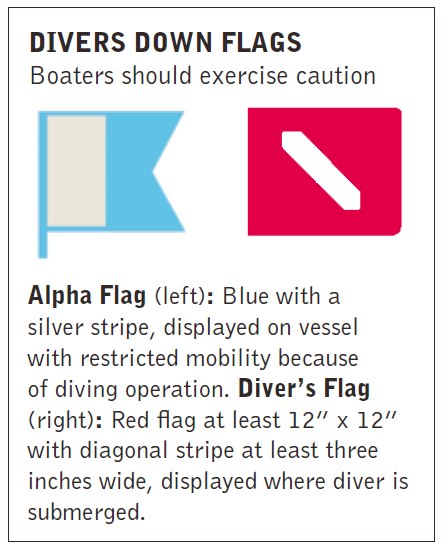 Swimming
Swimming
Swimming in whatever lake owned or managed by the KDFWR is prohibited except in areas specifically prepare aside for swimming at which a qualified lifeguard is on duty. Kentucky law specifically prohibits swimming at any boat launching ramp. Swim in marked and supervised areas. If you lot are a non-swimmer or a poor swimmer, wear a PFD. Remember, PFDs are not just for boaters.
Refrain from drinking alcoholic beverages when pond. Alcohol greatly reduces a person'due south reflexes and strength when in the water. For persons who accept had alcoholic beverages a PFD is the difference between life and death.
Persons who wish to swim a long distance should swim parallel to the shore instead of beyond a river or lake. Boaters don't normally expect to come across swimmers in the middle of a lake or river and may run over them.
INFLATABLES
Air mattresses, inner tubes and other similar devices are generally used as recreational items past persons swimming or sunbathing. Use of these items should exist restricted to designated or generally recognized swimming areas and not be used in areas of boat traffic. Not-swimmers or poor swimmers should not depend on these devices to save their life. These items can exist punctured and lose their buoyancy – wear a PFD!
LITTERING
(KRS 433.757)
The operator of any motorboat or vessel is responsible for any litter thrown into the water. Litter is not only unsightly, but tin be dangerous to humans and animals. For example, angling line discarded into the water can be chancy to wildlife and to a gunkhole's lower unit of measurement. Animals tin can be ensnared in the line and dice. Fishing line defenseless on a prop shaft tin crusade seal leaks and lower unit failure. Trot lines and limb lines tin can snare animals and other anglers in boats.
Top
RECKLESS Functioning
The operator of a watercraft is responsible for damage acquired by negligent operation. The following actions are considered reckless performance and are therefore against the law:
- weaving through traffic;
- following watercraft too closely that is towing an individual on waterskis, a surfboard or any water sport device;
- jumping the wake of another arts and crafts in a way that endangers man life, physical safety or holding;
- cut between a boat and the private(due south) being towed by the boat;
- crossing the path of another boat when visibility is obstructed;
- steering toward an object or individual in the h2o and turning sharply at shut range.
Persons shall not operate a motorboat or personal watercraft within 50 feet of a commercial vessel and its tow that is in operation on a waterway, except if the operator of the commercial vessel has given consent.
When operating in a decorated area, reduce speed and allow enough of room for avoidance maneuvers. Even in areas that are non marked as idle speed, excessive wake can nevertheless be unsafe. Operators of larger craft should be enlightened of the wake their vessels are throwing.
IDLE SPEED
Kentucky police defines idle speed as the "slowest speed possible to maintain maneuverability" of a boat. Generally speaking for a properly adjusted boat, this is the speed when a boat is put into gear without advancing the throttle. Wakes can invert modest boats or cause harm to boats moored at marinas and docks. It is extremely of import that boat operators exist aware of their speed and the resulting wake. Operators are liable for any injuries or damage caused by their boat's wake.
Boaters may run into buoys or signs that say "No Wake." This means that boats must exist at idle speed.
LOCKS AND DAMS
Boaters in Kentucky may come across lock and dam systems. Generally, these will be on the Greenish, Ohio and Kentucky Rivers (for the first four locks upstream to Frankfort, KY), but a few impoundments have a lock and dam. Locks are a relatively simple method of raising or lowering boats from one water level to some other. If lockage is desired, boaters should signal the lock operator past using the pull chain on each terminate of the lock or telephone call on marine channel 13. If the lock is non immediately available, boaters should position their vessels a prophylactic distance from the arroyo channel to avoid personal injury or damage to their gunkhole from wakes caused past commercial tows entering or leaving the locks. Never moor a vessel in the lock arroyo channels.
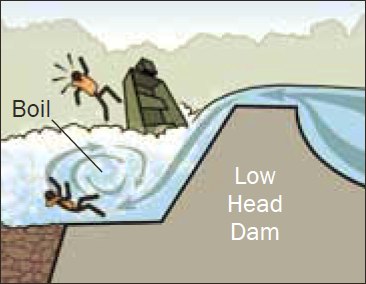
LOW HEAD DAMS ARE Unsafe
Depression head dams are unremarkably marked with "keep out" buoys or "danger" signs above and beneath. Low caput dams pose an fifty-fifty greater danger due to the fact that they are not as recognizable, peculiarly when water is flowing over them. It is this catamenia of h2o over the dam that creates a "boil" on the lower side. Boaters risk well-nigh certain death if defenseless in this turbulence.
Dams associated with the locks can be very dangerous. Below locks and dams on U.S. Army Corps of Engineers waterways and the Kentucky River, boat occupants must article of clothing a personal floatation device (lifejacket) upstream of danger signs and open-diamond buoys or within 150 anxiety of the downstream lock and dam wall. Anglers should never fish from or stand on lock and dam structures.
Boaters should be alert for these structures. Dams are either conventional or "low head" type. Conventional dams are easily recognizable with their spillways and power installations.
RESTRICTED ZONES
(KAR 6:030)
Kentucky law prohibits boats from operating inside restricted areas as posted above or below navigation, ability generating or inundation control dams.
No fish is worth risking your life. Be enlightened of trespassing and danger zones. Wear a PFD when entering whatever area above or below a dam.
OPERATING Under THE INFLUENCE
(KRS 235.240)
It is against the police to operate a gunkhole or vessel including personal watercraft, manipulate h2o skis, surfboard or other similar device while intoxicated or under the influence of whatsoever other substance that impairs one's driving ability. Whatsoever person who operates a vessel on Kentucky waters is considered to take given consent to a exam or tests to determine his alcohol concentration or the presence of other drugs. The tests shall be administered at the direction of a law enforcement officer who has probable cause to believe that the operator is intoxicated. An operator refusing the exam shall exist in violation of the law and subject area to the aforementioned penalties.
Anyone who operates a boat, PWC, skis, surfboard or like device while intoxicated with a blood booze level of 0.08 or higher or while nether the influence of any substance that impairs the operator's driving ability may be discipline to fines and possible jail time if convicted.
Minor Craft PRECAUTIONS
Statistics show that approximately one-half the boat-related fatalities involve boats that are less than 16' in length. These boats are usually unstable and can tip over, throwing the occupants overboard. Besides, these boats tin be easily swamped, especially if used on a large body of water where the wind tin can cause high waves. When using such arts and crafts, be enlightened of the hazards. Wearing a personal floatation device (PFD) is strongly recommended.
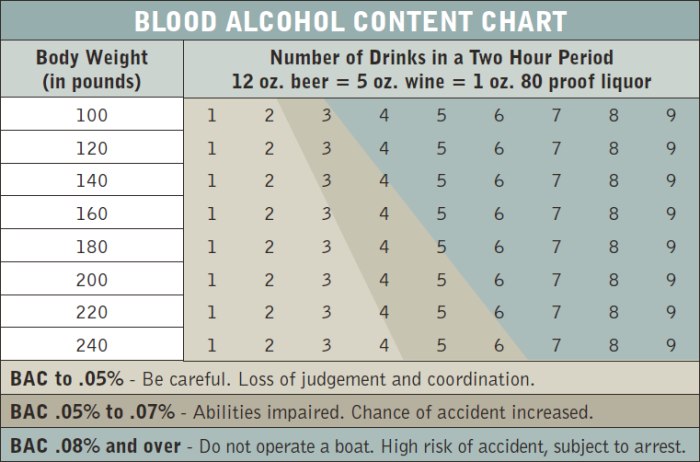
DRINKING IN PUBLIC AND PUBLIC INTOXICATION
(KRS 222.202)
Kentucky law specifically prohibits the drinking of alcoholic beverages in public places (this excludes establishments licensed to sell such beverages) and the waterways of this country are considered public places.
Further, in a public place, persons who are plain under the influence of alcoholic beverages to the extent that they may unreasonably annoy or endanger themselves or others shall be field of study to abort.
PROHIBITED RIDING
Approximately half of boat related fatalities issue from falls overboard. When operating a motorboat above idle speed the operator or passengers shall not ride on an enclosed bow, outside protective railing of a pontoon or houseboat, on a seat which extends six inches above the plane of the gunwales, nor shall they ride on the sides, back, engine cover, back of seat, or any other obviously dangerous position which could atomic number 82 to falling overboard.
Top
Boats Keep Out!
Nature of danger may be placed outside crossed diamond, e.g., waterfalls, swim areas or rapids.
Danger!
Nature of danger may exist indicated inside the diamond shape, east.grand., rocks, reefs, dams, construction or snags.
Caution!
Controlled Areas as indicated in circumvolve, e.m., speed limit, no fishing, no anchoring, ski-only, slow-no wake, no ski or no prop boats.
Information
Tells directions, distances, places such as food, repair, supplies and other non-regulatory messages.

Obstacle
Marker Do not pass between shore and beacon.
Mooring Buoy
White with reflective blueish ring. May have white light or reflector.
Aqueduct Marking
 Keep beacon on right facing upstream.
Keep beacon on right facing upstream.
Aqueduct Marker
Continue buoy on left facing upstream. Marker may be green or black.
Boaters on the h2o run into three situations: meeting, crossing and overtaking. The following diagrams should requite a clear explanation of who has the right of way (stand-on vessel) and who must give mode (give-way vessel). However, in an emergency, all vessels must give way to avoid a collision. At night, a gunkhole'south navigation lights requite an indication of right of mode.On the h2o there are no painted lines to mark where boats must go. In society to provide an orderly period of traffic, at that place are "rules of the road" that boaters should acquire and practice.
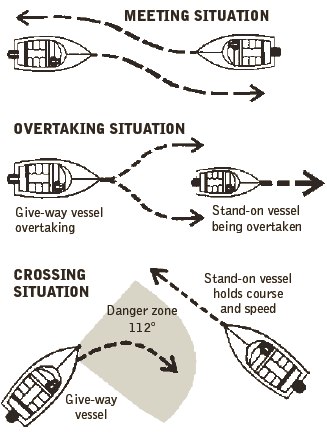
The above rules cover virtually traffic situations, but a few other situations exist. Sailboats nether sail accept the correct of way except when they are the overtaking vessel. Rowboats and paddle powered boats take the right of way over motorboats. All recreational arts and crafts should yield the right of way to large commercial craft (towboats, barges). Such vessels have big blind spots and volition exist unable to see smaller crafts in front of them.
On small or narrow bodies of water, all traffic should stay to the correct of mid-channel and not "cutting corners".
BUOYS
Buoys are the nearly common types of navigational aid, and they serve the same purpose as traffic signs on the highway. Failure to obey buoys can result in enforcement action, or worse, a loss of holding or lives. When boating in unfamiliar waters, slow down and await for whatever regulatory or channel-mark buoys. Call up that information technology is possible for these buoys to drift out of position. Kentucky law prohibits from tying up to whatever beacon except designated mooring buoys.
Top
(301 KAR half dozen:040 Sect. 4)
For each person onboard a vessel, federal as well equally state law requires a Type I, Two, or 3 personal flotation device (PFD) on all boats. Boats sixteen feet and over, except canoes and kayaks, must also carry 1 Type IV throwable PFD. Operators and passengers of personal watercraft must vesture a PFD. Persons under 12 years of age must clothing a PFD while in the open part of a gunkhole that is under way.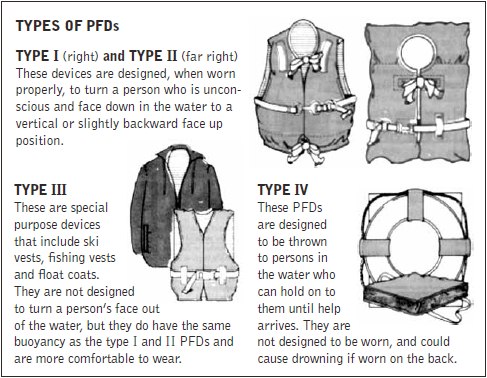
PERSONAL FLOTATION DEVICES
Kentucky Fish and Wild animals strongly recommends wearing PFDs while boating, especially by children and non-swimmers. In gild for PFDs to be legal, the post-obit requirements must be met:
- Coast Guard approved: A label with an approval number will be on the PFD. Bank check the label on inflatable types of PFDs. Some older models meet Coast Guard blessing only when worn.
- Serviceability: All straps, buckles, zippers, stitching, must be intact and the textile should not be rotted. Some PFDs contain airtight bags filled with a fibrous material. Clasp the numberless. If air escapes, destroy the PFD and supercede it with a new ane.
- Size: PFDs must fit properly. Read the label to determine size and weight restrictions.
- Accessibility: PFDs must be readily available for immediate use past all occupants of a vessel. It is advisable for each person to try on their PFD before departing so that they are familiar with the fastening devices and to assure information technology is adjusted to the person. PFDs shouldn't exist stored in the plastic bags in which they were sold. This limits access and can promote rotting.
FIRE EXTINGUISHERS
Kentucky law requires that all boats equipped with a petroleum product (gasoline, kerosene, propane, etc.) consuming device (engines, lanterns, stoves, etc.) shall have a manus portable fire extinguisher in serviceable condition and located for immediate use. The all-time fire protection is well maintained equipment and proper prophylactic habits.
At that place are fuels other than gasoline that cause fires. Many houseboats use bottled gas (propane) for stoves and other appliances. Also, many fishermen will use a lantern while fishing at night; if tipped over it can cause a fire.
| MARINE FIRE EXTINGUISHER CLASSIFICATION | ||||
| Coast Baby-sit Classes | UL Listing | Foam (gals.) | CO2 (lbs.) | Dry Chemic (lbs.) |
| B-I | 5B | 1.25 | 4 | ii |
| B-II | 6B* | 2.5 | fifteen | 10 |
| - | 10B | none | 10 | 2.five |
| - | 20B | 2.5 | 50 | 4.five-half-dozen |
| MINIMUM NUMBER OF B-one Burn down EXTINGUISHERS | ||
| Vessel/size | No Fixed Burn Extinguisher System | Fixed Fire Extinguisher Arrangement Installed |
| Class A | 1 | 0 |
| Grade 1 | 1 | 0 |
| Class 2 | 2 | ane |
| Grade iii | 3 | 2 |
Backfire FLAME ARRESTERS
Internal combustion engines may backfire. To safeguard against fire, all motorboats with enclosed engines and engines originally equipped with a flame arrester, (except outboards and diesels) must have an approved carburetor backfire flame arrester organization on each carburetor.
VENTILATION
Nigh fires on a boat are due to ignition of fuel vapors. Gasoline is heavier than air. It can collect in the bilge or engine compartment and any spark tin ignite it. Therefore, Kentucky law requires boats to have adequate ventilation of areas where combustible vapors tin can accrue.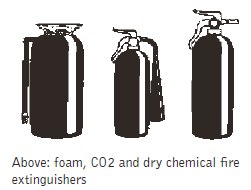
Well-nigh boats are equipped with adequate ventilation systems when they come from the factory. Usually, this is a combination of active and passive systems. Active systems utilize electrical blowers to exhaust flammable vapors from the bilge and other areas. Passive systems are ducts and cowls that ventilate areas when the boat is moving. Almost all inboards will have an electric blower installed in the engine compartment. Operators should run the blower for several minutes before starting the engine. If the blower is inoperable it should be repaired or replaced immediately. Many gunkhole fires accept place after refueling, so care should be taken to avert spilling fuel in the vessel.
NAVIGATION LIGHTS
All vessels when underway between sunset and sunrise must brandish proper navigation lights. Navigation lights on boats are restricted to the colors of red, dark-green and white.
From sunset to sunrise in an surface area where other boats navigate, all vessels at anchor shall display a steady white light visible 360 degrees at all times. Manually propelled vessels shall carry a white light to brandish in sufficient fourth dimension to avoid a collision.
The purpose of the red and light-green navigation lights at night is to prove if your gunkhole is in a coming together, crossing or overtaking situation. The red and green lights must exist displayed from sunset to sunrise whenever a gunkhole is underway. They will give some indication of the size and speed of vessels. The blood-red and greenish bow lights are especially helpful in determining right of way in crossing situations. In the diagram beneath, boat B sees the greenish bow calorie-free of boat A, and has the right of way to go on on course. Boat A sees the red bow light of boat B and must stop or pass astern of boat B. In special circumstances, such as towing, refer to 33 CFR 83 (Inland Navigation Rules).

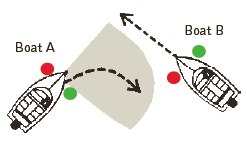
SIGNALING DEVICES
Kentucky police states that all boats sixteen feet in length or longer must have a hand-, oral fissure- or power-operated signaling device capable of producing a nail for two seconds or more and audible for i-one-half mile for grade one vessels, one mile for grade two vessels and i and half miles for grade 3 vessels. This does non exempt vessels from any other signaling device as may exist required by federal law when operating on navigable waters of this country.
Navigation law also requires the post-obit maneuvering and alarm signals:
- I long blast: Alarm point (coming out of slip)
- One short boom: Laissez passer on my port side (left)
- 2 short blasts: Pass on my starboard (correct)
- Iii brusk blasts: Engines in reverse
- Five or more than blasts: Danger signal
MUFFLING DEVICES
Kentucky police requires all boats to be equipped with constructive exhaust muffling devices. Usually, boats and motors that come up direct from the manufacturer are adequately deadened. However, there may be instances of loftier operation boats that have been modified past the owners that are not in compliance with the police. Additionally, in that location may be federal and/or local regulations restricting boats with an over-the-transom frazzle organisation.
MARINE SANITATION DEVICES
(KRS 235:420)
Motorboats with marine toilets are not allowed on public waters unless the toilet is equipped with a Type I, II or 3 marine sanitation device (MSD.) Type I and Ii MSDs chemically treat sewage. Type Three MSDs are holding tanks for raw sewage.
Raw sewage shall not be discharged in whatsoever public waters. Treated sewage may exist discharged from a marine toilet into legal "discharge" waters. Those waters are Barkley and Kentucky lakes, Lake Cumberland and any of the major river systems. Type I and 2 MSDs must be sealed or locked while the vessel is on "no discharge" waters.
Top
(301 KAR 6:030, KRS 235.250)
REPORTING REQUIREMENTS
If any of the following conditions occur equally the result of a canoeing accident, standoff, etc., a Boating Accident Report must be fabricated:
- death or disappearance of a person;
- injury to a person which requires medical attending or incapacitates that person for 24 hours or more;
- loss or damage to property (including the vessel) in an amount of $500 or more than.
The operator of a vessel is required to complete the report. If the operator is not capable of filing the report and is non the possessor of the vessel, and so the owner shall be required to make full out a boating accident report.
Notation 1: Even if a Law Enforcement Officeholder fills out a canoeing accident report, this does non exempt the operator from filing a report.
Note ii: The reports filed by operators of vessels are confidential and are not available as public record (KRS 235.250). However, reports made past officers are bachelor for review.
Accidents involving decease or serious injury must be submitted to the Division of Constabulary Enforcement within 48 hours. All others must be submitted within five days.
Boating accident report forms are available from wild fauna and boating police force enforcement officers or by writing to Kentucky Section of Fish and Wild animals Resources, Division of Police Enforcement, #ane Sportsman's Lane, Frankfort, KY 40601, by calling one-800-858-1549 or online.
RENDERING Assist
An operator of a vessel involved in a boating blow shall render aid to other persons and vessels as long equally it doesn't endanger his crew, passengers or vessel. Besides, the operator of whatsoever vessel involved in an accident shall requite his name, address, and identification of his vessel, in writing, to any person that is injured or to the owner of any property that is damaged.
FIRST AID
This department includes suggestions that may save a life. First, boats should be equipped with a showtime aid kit. This kit should be able to provide treatment for burns, insect bites, cuts and abrasions.
Second, boaters should take a kickoff assist class and so they know how to treat victims with sprains, broken bones and shock.
3rd, boaters should know how to perform Cardiopulmonary Resuscitation (CPR) in case they encounter victims of nearly drowning, eye assail or trauma from canoeing accidents. In many cases, emergency medical assist is farther away on the water than on land. Interested persons should contact their local chapter of the American Red Cross for data on beginning aid and CPR training.
HYPOTHERMIA
4 elements cause hypothermia – common cold, wet, current of air and exhaustion. Symptoms of hypothermia are uncontrollable shivering, slurred speech, stumbling, blueish skin, decreased centre and breathing charge per unit, weak pulse and unconsciousness.
All hypothermia symptoms need immediate attention. Equally soon as possible, a victim of hypothermia should be brought out of the weather. Wet clothing should be replaced with dry clothing. If the victim shows mild symptoms, get them near a fire or other heat source or put them in a warm sleeping bag. For victims with advanced symptoms of hypothermia, seek immediate medical attending. Never give alcohol to the victim.
The all-time cure for hypothermia is prevention. Monitor weather reports when you lot plan to be in the outdoors. Clothes in layers and always accept foul-atmospheric condition gear handy.
FATIGUE
Boaters should be aware of the factors that induce fatigue while on the water. The wind, lord's day, engine noise and abiding motility of the boat can greatly reduce a person's reaction time.

Source: https://fw.ky.gov/FishBoatGuide/Pages/Boating.aspx
Posted by: swansonfulta1954.blogspot.com


0 Response to "Where Are The Most Regulator Boats Registered"
Post a Comment